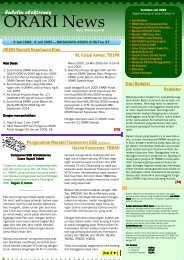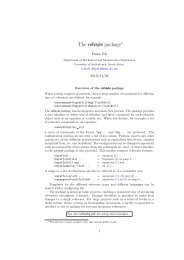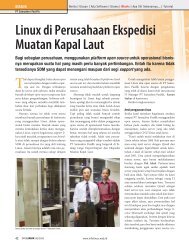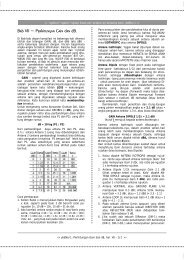You also want an ePaper? Increase the reach of your titles
YUMPU automatically turns print PDFs into web optimized ePapers that Google loves.
3.2.3 Example Showing Detailed Use of the Computer in<br />
Class C R-F Power Amplifiers<br />
Assume that we have an EIMAC 4CX20,000A/8990 tetrode and<br />
want to make it work efficiently. Also assume that we have a 10<br />
kilovolt d-c power supply available.<br />
Within frequency limits, we know that a tube should be able to run<br />
in Class C amplifier service with about 75% efficiency or higher,<br />
or, in other words, to convert 75% of the d-c anode input power<br />
to r-f output power. The difference, or 25% of the input power, is<br />
dissipated and lost as heat on the anode of the tube. The d-c anode<br />
input power is then about four times the power dissipated on the<br />
anode.<br />
The 4CX20,000A/8990 tetrode has a maximum rated anode<br />
dissipation of 20 kilowatts. To illustrate performance near the<br />
maximum rating, we will choose an input power about 1.5 to 2 times<br />
the dissipation rating, or about 30 - 40 kilowatts. At 10 kilovolts the<br />
dc anode current must then be 3 to 4 A. We will use 3.2 Amperes of<br />
anode current for our example, striving for 80% efficiency. We hope<br />
to obtain at least 25 kilowatts of output power. It is normal practice<br />
with tetrodes and medium or low µ triodes in Class C amplifier<br />
service for the d-c grid bias voltage to be roughly two to three times<br />
the grid voltage necessary to cut off the flow of anode current. By<br />
referring to the curves for the 4CX20,000A/8990, it is decided to<br />
use a d-c grid bias voltage of -400 volts. Higher bias voltage may<br />
be employed in applications where highest possible efficiency is<br />
desired (and additional drive power is available). In such a case,<br />
points will have to be established below the bottom-most line in<br />
the data sheet, which is –400 Volts, by scaling a new grid voltage<br />
line horizontally below the existing line. Scaling for higher anode<br />
voltage can also be done in this way (within the absolute maximum<br />
ratings established for a given tube type).<br />
Now locate the operating line on the constant-current curves for<br />
the 4CX20,000A/8990. (See Figure 27). First, mark the point where<br />
the d-c grid bias and d-c anode voltage cross. The operating line<br />
must go through this point, which can be referred to as “Point No.<br />
l.” Next, the peak value of the anode current and how low we can<br />
let the instantaneous value of anode voltage (ebmin) be when<br />
the tube is passing this much current must be decided. This is<br />
necessary in order to locate the other end of the operating line,<br />
e.g., “Point No. 2 “.<br />
The peak value of anode current in Class C amplifiers can range<br />
from three to five times the value of average d-c anode current, the<br />
38
















